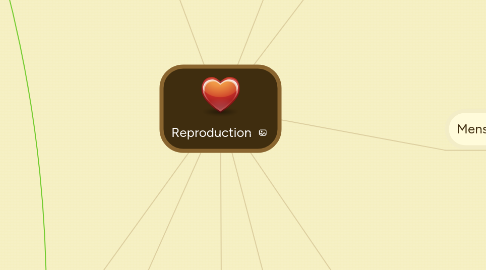
1. Fertilization
1.1. Fusing of Sperm and Ovum
1.1.1. One sperm penetrated egg cell membrane
1.1.1.1. Sperm Penetrates through 2 layers
1.1.1.2. Zona Pellucida
1.1.1.2.1. Strong Layer Surrounding ovum, developed in follicle. Stays around ovum after discharge. For sperm to penetrate it uses enzymes to digest layer. This is called acrosomal reaction
1.1.1.3. Corona Radiata
1.1.1.3.1. A layer of follicle cells surrounding ovum immediately after it's discharge from follicle.
1.1.1.4. After penetration
1.1.1.4.1. Cortical Reaction
1.1.1.4.2. After successful penetration by one sperm, cortical granules inside the ovum release enzymes through exocytosis and some enzymes react with zona pellucida to form a fertilization envelop which prevents other sperms from penetrating ovum
1.1.2. Nuclei of both gametes fuse
1.1.3. Form Diploid (2n) Zygote
1.1.4. Initiates Cleavage Process
1.2. After Ejaculation
1.2.1. Sperms swim up Female reproductive tract to fuse with egg at Fallopian tube
2. Intercourse
2.1. Defined By Insertion of a male's penis into a female's vagina to deposit Semen
2.2. Four phases
2.2.1. 1.Preparation Phase
2.2.2. 2.Plateau Phase
2.2.3. 3.Orgasm Phase
2.2.4. 4.Resolution Phase
3. Puberty
3.1. Defined by period whereby a body goes through rapid developments to become capable of sexual reproduction.
3.2. Male
3.2.1. Triggers Spermatogenesis
3.2.2. Enlargement of Penis and Testes
3.2.3. Become muscular
3.2.4. Growth Spurt
3.2.5. Growth Of Pubic Hair
3.3. Female
3.3.1. Ovaries and vagina increase in size
3.3.2. Menstruation Begins
3.3.3. Growth of pubic hair
3.3.4. Hips widen
3.3.5. Breasts develop
3.3.6. Growth Spurt
3.4. Triggered by GnRH released by Hypothalamus
3.4.1. Releases LH and FSH from anterior pituitary gland
3.4.2. Lutenizing Hormone (LH)
3.4.3. Follicle Stimulating Hormone (FSH)
4. Cleavage, Implantation and Gastrulation
4.1. Takes place After Fertilization
4.2. Cleavage
4.2.1. Occurs While Zygote is taken to Uterus
4.2.2. Cells divide to form embryo through mitosis
4.2.3. Converts unicellular zygote to multicellular embryo called blastocyst
4.2.3.1. A ball of cells with some internal cells
4.2.4. Cells called blastomeres
4.2.4.1. Become smaller each division -> to maximize surface area to volume ratio for most efficient absorbtion of necessary nutrients
4.3. Implantation
4.3.1. Implantation of embryo in endometrium
4.3.1.1. Embryo binds to endometrium and then penetrate
4.3.2. Transforms embryo to a fetus
4.4. Gastrulation
4.4.1. Movement of cells, take up different locations to allow formation of organs and tissues
4.4.2. Forms 3 layers
4.4.2.1. Ectoderm
4.4.2.2. Endoderm
4.4.2.3. Mesoderm
4.4.3. Little research done on human gastrulation
4.4.3.1. Ethical issues
5. Sexual organs
5.1. Male
5.1.1. Penis
5.1.1.1. Deposits sperm in vagina
5.1.1.2. Conducts Sperm From testes to Vagina
5.1.2. Testis
5.1.2.1. Produces sperm and Hormones
5.1.3. Vas deferens
5.1.4. Glands
5.1.4.1. Seminal Vesicle
5.1.4.2. Bulbourethral Gland
5.1.4.3. Prostrate Gland
5.1.5. Scrotum
5.1.5.1. Pouch supporting testes.
5.1.6. Urethra
5.1.6.1. Conducts Semen from Vas deferens
5.1.7. Epididymis
5.1.7.1. Stores Sperms
5.2. Female
5.2.1. Vagina
5.2.1.1. For entry of Penis and Sperm
5.2.2. Ovary
5.2.3. Cervix
5.2.3.1. Closes off lower end of uterus
5.2.4. Uterus
5.2.4.1. Lined With Endometrium
5.2.4.2. Endometrium Richly Supplied with blood vessels
5.2.5. Fallopian Tubes
6. Gamete production
6.1. Production of haploid gametes
6.1.1. Male (Spermatogenesis)
6.1.1.1. Division through Meiosis
6.1.1.1.1. 1.Duplication of DNA from one chromatin
6.1.1.1.2. 2.Genetic recombination
6.1.1.1.3. 3. Separation of chromosomes
6.1.1.2. Process
6.1.1.2.1. 1.Multiplication of stem cell through mitiosis to ensure steady supply
6.1.1.2.2. 2. Spermatogonia grow in size
6.1.1.2.3. 3. Meiosis I to form primary spermatocytes
6.1.1.2.4. 4.Meiosis II to form spermatids
6.1.1.2.5. 5.Spermatids undergo differentiation to form sperms
6.1.2. Female (Oogenesis)
6.1.2.1. 1.Growth of oogonia to form primary oocyte, develops in follicle
6.1.2.2. 2.Growth Of Follicle
6.1.2.3. 3.Growth of primary oocyte
6.1.2.4. 4. Meiosis I to form secondary oocyte
6.1.2.5. 5.Ovulation
6.1.2.6. 6.If ovum is fertilized then Meiosis II to occur
7. Menstrual Cycle
7.1. Menstruation
7.1.1. Day 1-5 of cycle
7.1.2. Endometrium, disintegrated egg, and blood are shed through vagina
7.1.3. Contraction of muscles in uterus
7.2. Thickening of endometrium
7.2.1. To prepare for implantation of embryo
7.2.2. Endometrium grows thick and full of blood vessels
7.3. Ovulation
7.3.1. Release of ovum into fallopian tube
7.3.2. Day 14 - 16 of cycle
8. Abortion
8.1. Defined by the deliberate termination of Pregnancy
8.2. Use of surgical procedures to remove a developing foetus from a womb
8.3. Complications
8.3.1. Risk of infertility
8.3.2. Heavy bleeding due to puncture of womb
8.3.3. Emotional or psychological problems
8.4. Ethical Issues
8.4.1. Whether "right" to abort a woman of her child.
8.4.2. Is it considered as "killing" a person?
9. Sexually Transmitted infections
9.1. Caused by virus/micro-organisms
9.2. Transmitted by
9.2.1. Sexual Contact
9.2.2. Exchange of body fluids
9.2.3. From a mother to a baby
9.3. Examples
9.3.1. Syphilis
9.3.1.1. Caused by "Spiral" bacteria
9.3.1.2. Effects
9.3.1.2.1. Painless sores on penis, Vagina, skin.
9.3.1.2.2. Non-itchy rashes
9.3.1.2.3. Paralysis
9.3.1.2.4. Deformed Joints
9.3.1.2.5. Baby infected through mother may be deaf or have abnormal teeth
9.3.1.3. Cure
9.3.1.3.1. Can be cured using antibiotics at the early stage
9.3.2. Aids
9.3.2.1. Caused by Human Immunodeficiency Virus (HIV)
9.3.2.2. Effects
9.3.2.2.1. Victim's immune system goes down.
9.3.2.2.2. Victim prone to other diseases like cancer.
9.3.2.3. Cure
9.3.2.3.1. No cure currently
